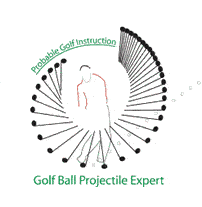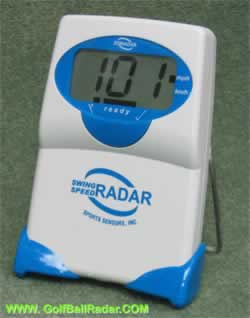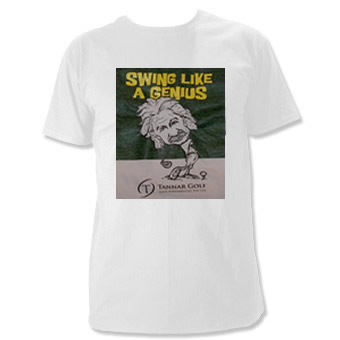
|
|
Golf's Short GameCan you shoot lower scores without physical improvement? The answer is a resounding, YES! Not that I'm advocating not improving your ball striking and short game skill level. How well you score on the course is dependent on the following: † Ball striking
ability (distance
and accuracy).
In this next series of newsletters, I'll be emphasizing ways that you can improve your Game Managment, which in my view, is getting the most out of your current skill level Probably the easiest way most amateur golfers could improve their game management to lower their scores is to hit more club on all their shots. In a poll on my website, out of 484 golfers taking the poll, over 65% of golfers come up short over 50% of the time. It has been my experience that most full shots that fall short of the target are due to not hitting enough club. Just like your handicap is an average of your best 10 rounds of the last 20, golfers tend to gage how far they hit their clubs based on their BEST instead of their average. Consider this simple analysis of how many strokes this under clubbing costs. I'll use my own statistics in the analysis which are my short game averages: Wedge 10-40 yards = 2.8 strokes = E(Wedge) =
Expect #strokes
with wedge Let's assume I'm hitting an iron to a green on a par 4. If I hit the right club for the shot and execute the shot adequately, I'll put the ball on the green (let's say 15-30 ft from the pin). Based on my putting statistics, I would on average take 1.9 more strokes to hole the ball for a total of 2 + 1.9 = 3.9 strokes. If I underclub, I'll come up short of the green and either need to wedge or chip the ball onto the green; I'll assume an average of 2.6 strokes (half chips and half wedges). Based on my short game statistics, I would on average take 2.6 more strokes to hole the ball for a total of 2 + 2.6 = 4.6 strokes. I'd make bogie over half of the time. The difference between these two scenarios is 0.7 strokes. If I underclub on half of the 18 holes, that's 9 X 0.7 = 6.3 strokes more for a single round. That's a lot of strokes. And, this is assuming I have a relatively good short game. The weaker my short game, the greater the difference in strokes (once again, empha- sizing the importance of the short game). And, of course, if there is a hazard in front of the green, the penalty for falling short is even greater.
Now, you might argue that if there are hazards left or right of the green, then hitting the right club would put them into play, whereas under clubbing would eliminate them. You're right. We would need to know your "shot pattern" (percentage of shots you hit left, right, short, long) to estimate the effect. Suffice to say that hitting the right club more often will reduce your score. >One of the services I provide golfers is a "shot pattern" analysis. I'll be discussing shot patterns in greater detail in future newsletters. The concept is extremely important in making wise club choices on shots; knowing where you are likely going to hit the ball and how that overlaps with the golf hole hazards. If you would like to have your precise shot pattern determined, you can collect 10 rounds of statistics and email them to me. I'll do a free analysis for you and send you the results. Or you can purchase a year's subscription for only $15.99 Canadian. You just continue to send me your stats and I'll determine your shot pattern and make recommendations. See a sample report here. Click here for your free analysis. Purchase a year's subscription. If you have any questions or comments, feel free to email me at golfexpert@probablegolfinstruction.com ©Probable Golf Instruction, Ken Tannar 2001-2015. All Rights Reserved. Langley, B.C. V2Y 2G4 CanadaPhone: 604-309-7030 FAX: to fax, email an attachment probablegolf@yahoo.ca or golfexpert@probablegolfinstruction.com |
| GOLF ASSISTANTS |
|
Golf Trip Pairing CalculatorPlanning a golf trip with some friends/family? Trying to sort out the foursomes so people don't play too often with others? Order your ready made Spreadsheet. Type in the names, print out the groupings. Minimize repeat pairings.
Wind Caddy will advise you on aim, distance and club so that you can play the wind successfully. It takes the guess work out of club selection. New option to enter custom distances for each club. The algorithm will make a club suggestion accordingly. Use the right club in every condition!
|
|
|
| GOLF NEWS |
Golf Putting Green Reading Glasses |
| GOLF NEWSLETTER |
Statistics
·Putting
·Longest Golf Balls
·Games
·Handicap
·Scoring
·Shot Patterns
·Tournaments
·PGA Tour Stats
Pro Shop
·Ball Marker Engraved
·Books
·CDs & DVDs
·Green Reader
·Impact Labels
·Laser Rangefinder
·Longer Drives
·Products
·Teaching Aids
|
|
| GOLF POLL |
The 19th Hole
·Advertising
·Ask the Golf Expert
·Consultation/Litigation
·FAQs
·Golf Blog
·Golf Draws
·Links
·Science of Golf
·Tell a Friend
·Testimonials
·

Golf Ball Finder Glasses
Find all your errant golf balls and many more!
| GOLF TIPS |
How to play:
|




